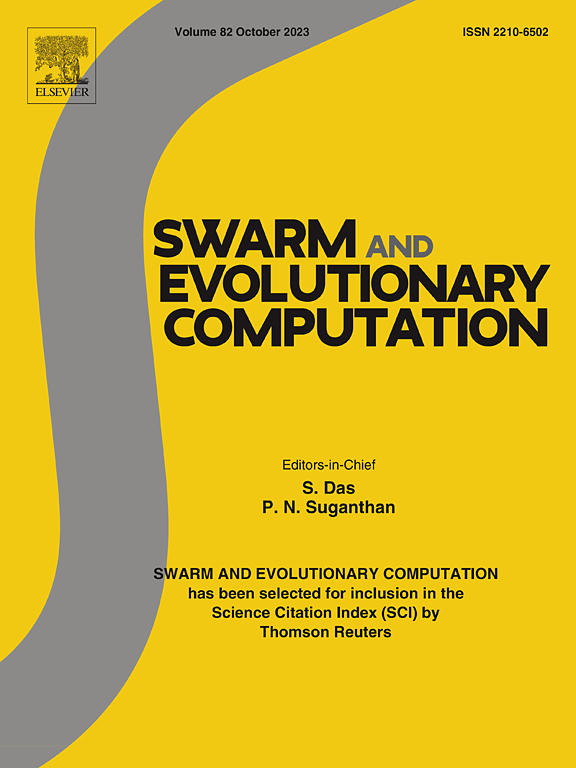区间不确定多目标优化的非概率集选择策略
IF 8.5
1区 计算机科学
Q1 COMPUTER SCIENCE, ARTIFICIAL INTELLIGENCE
引用次数: 0
摘要
不确定性给多目标优化带来了巨大的挑战,因为解不再是确定性值,使解质量的准确评价和精英解的选择复杂化。对不确定解之间的优势关系判断错误可能导致优解的丢失,不精确的拥挤距离量化可能无法保持种群多样性。为此,提出了一种新的基于非概率集合的选择策略(NPS)来平衡不确定种群的收敛性和多样性。该算法采用了一种新的二维区间优势关系和区间拥挤距离模型来确定新的亲本群体。此外,采用一种非侵入式的不确定性分析模型——维度方法(DWA)来量化不确定优化目标的边界。此外,为了提高不确定种群多样性评价的准确性,提出了一种基于区间拥挤距离的样本标准差度量。将该算法集成到两个经典的多目标优化框架中,并与其他多组基准的选择策略进行了比较。结果表明,结合NPS和DWA的算法不仅可以有效地探索不确定条件下的Pareto Front,而且可以直接评估有限样本下的不确定解。与其他选择策略相比,NPS能够探索出收敛性好、多样性高、不确定性小的最优解集。本文章由计算机程序翻译,如有差异,请以英文原文为准。
Non-probabilistic set-based selection strategy for multi-objective optimization with interval uncertainties
Uncertainty introduces great challenges for multi-objective optimization, as the solutions are no longer deterministic values, complicating both the accurate evaluation of solution quality and the selection of elite solutions. Misjudging the dominance relationship among uncertain solutions may result in the loss of superior solutions, and imprecise crowding distance quantification may fail to maintain population diversity. Therefore, a novel non-probabilistic set-based selection strategy (NPS) is developed to balance the convergence and diversity of uncertain populations. It employs a novel two-dimensional interval dominance relationship and an interval crowding distance model to determine the new parent population. Additionally, a dimension-wise approach (DWA), a non-intrusive uncertainty analysis model, is used to quantify the bounds of uncertain optimization objectives. Furthermore, a novel interval crowding distance-based sample standard deviation metric is proposed to enhance the accuracy of diversity evaluation for uncertain populations. The proposed NPS is integrated into two classical multi-objective optimization frameworks and is compared with other selection strategies across multiple groups of benchmarks. The results indicate that algorithms incorporating NPS and DWA can not only effectively explore the Pareto Front under uncertainties but also directly evaluate uncertain solutions with limited samples. Compared with other selection strategies, NPS can explore an optimal solution set with superior convergence, higher diversity, and lower uncertainty.
求助全文
通过发布文献求助,成功后即可免费获取论文全文。
去求助
来源期刊

Swarm and Evolutionary Computation
COMPUTER SCIENCE, ARTIFICIAL INTELLIGENCEC-COMPUTER SCIENCE, THEORY & METHODS
CiteScore
16.00
自引率
12.00%
发文量
169
期刊介绍:
Swarm and Evolutionary Computation is a pioneering peer-reviewed journal focused on the latest research and advancements in nature-inspired intelligent computation using swarm and evolutionary algorithms. It covers theoretical, experimental, and practical aspects of these paradigms and their hybrids, promoting interdisciplinary research. The journal prioritizes the publication of high-quality, original articles that push the boundaries of evolutionary computation and swarm intelligence. Additionally, it welcomes survey papers on current topics and novel applications. Topics of interest include but are not limited to: Genetic Algorithms, and Genetic Programming, Evolution Strategies, and Evolutionary Programming, Differential Evolution, Artificial Immune Systems, Particle Swarms, Ant Colony, Bacterial Foraging, Artificial Bees, Fireflies Algorithm, Harmony Search, Artificial Life, Digital Organisms, Estimation of Distribution Algorithms, Stochastic Diffusion Search, Quantum Computing, Nano Computing, Membrane Computing, Human-centric Computing, Hybridization of Algorithms, Memetic Computing, Autonomic Computing, Self-organizing systems, Combinatorial, Discrete, Binary, Constrained, Multi-objective, Multi-modal, Dynamic, and Large-scale Optimization.
 求助内容:
求助内容: 应助结果提醒方式:
应助结果提醒方式:


